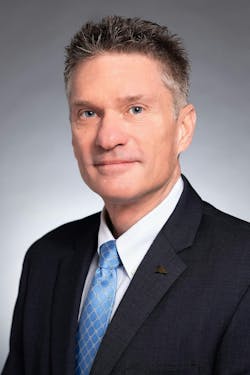Charting a Course for HVACR Change
For this edition of our 2024 special section, "What's New? What's Next?" in which we provide focused responses from leading brand executives, we feature Doug Widenmann, Senior Vice President, Marketing for Daikin Comfort Technologies, North America. Daikin is celebrating its 100th Anniversary as Contracting Business Celebrates its 80th year as a leader in HVACR publishing. - ed.
Contracting Business: Please share Daikin's progress to date related electrification manufacturing goals and why those products will be signficicant technological developments.
Doug Widenmann: Daikin is a responsible company that believes in being a good corporate steward and improving society. We support this responsibility through the development of advanced technologies based on Daikin’s core strengths of inverter, heat pump and refrigerant management. In 2018 Daikin Comfort Technologies North America, Inc. (DNA) launched Daikin FIT, a compact, efficient, and quiet, communicating horizontal discharge ducted unitary system. These systems have been very successful for Daikin and our contractors appreciate the ease of installation and application flexibility not to mention the comfort and efficiency they offer.
Daikin formulated Environmental Vision 2050 in an effort to achieve net zero greenhouse gas emissions (carbon neutrality) by 2050.
The significance of Daikin FIT is multifaceted. The units are compact, highly efficient and use significantly less refrigerant than traditional cube-style units, such as Daikin’s DZ18TC non-inverter cube style heat pump with efficiencies up to 19 SEER. This combination of small footprint which supports long term affordability concerns, superior efficiency and the dramatic reduction in refrigerant required to deliver a high-performance system are critical to meet goals as we experience a phase down in HFC refrigerants and future DOE minimum efficiency requirements.
CB: Decarbonization is of course related to electrification, but can something be provided about how you are progressing in meeting decarbonization goals?
DW: From a global perspective, from Daikin Industries, Ltd. in Osaka, Japan, air conditioners have become vital to people’s lives around the world, and yet they emit large amounts of CO2 through energy consumption during use and from the impacts of their refrigerants. As the only manufacturer in the world to produce both air conditioners and refrigerants, Daikin recognizes it has a major social responsibility. Daikin formulated Environmental Vision 2050 in an effort to achieve net zero greenhouse gas emissions (carbon neutrality) by 2050. Under the Fusion 25 Strategic Management Plan, which targets fiscal 2025, Daikin has positioned “Challenge to achieve carbon neutrality” as one of its growth strategies. The target for this strategy aims to lower net greenhouse gas emissions by 30% or more in 2025 and by 50% or more in 2030, with 2019 as the base year. Using innovative initiatives reflected in this management strategy, we will develop a roadmap to net zero greenhouse gases and aim to balance business growth with these goals.
Daikin has a “Simple. Powerful. Sustainable.” approach to decarbonization that revolves around the core technologies — low-global warming potential (GWP) refrigerants, inverter compressors and heat pumps — developed to create comfortable, efficient, and sustainable spaces to live and work.
From a United States and Canadian perspective, Daikin is promoting decarbonization through advancements in fully communicating equipment with inverter heat pump technology. Daikin continues to expand its Daikin FIT heat pump product offerings which we believe provide the best solution to address the need for efficient products, alternatives to traditional fossil fuel heating systems and reduced refrigerant volume, compared to cube style R-410A systems of like capacity, which is key.
Daikin has chosen R-32 refrigerant. We believe R-32 is the best choice to realize decarbonization goals for several reasons. First, it is a proven commodity. R-32 is the global low GWP refrigerant standard with over 230 million installations worldwide. It is a simple refrigerant because it is not a blend like other A2L alternatives or even R-410A. As a pure, single-component refrigerant, R-32 can be topped off and recharged in the field, in both liquid and gas phases, without changes in composition. It is easy to clean and reuse on-site and is easy to reclaim off-site with a simple cleaning process, particularly as compared to blends with HFOs that are typically reclaimed by being distilled to their pure compounds and then remixed. It is more efficient and has more capacity than other A2L alternatives like R-454B. R-32 is readily available and is not a proprietary refrigerant.
Finally, DNA is investing in refrigerant recovery. For more than a year now, through our company owned distribution channels, we have been actively recovering refrigerant from our contractors. We have established a simple program for contractors to participate in and have established aggressive targets for our sales teams to make it easy and desirable for our contractors to get paid for used refrigerant that can be recycled and reused.
CB: Please share an update on the status of Daikin's A2L refrigerant product development related to making products available to contractors by fall/end of 2024. Which refrigerant will you use and why?
DW: From an R-32 readiness perspective, we have been selling Daikin ATMOSPHERA ductless mini-splits with R-32 refrigerant since late 2021 in the United States where local codes allow. We have launched two additional R-32 ductless mini-split systems, Daikin ENTRA and Daikin OTERRA, earlier this year. We will continue to introduce additional single mini-split pair and multi-port systems throughout the remainder of the year. For unitary product, we are ready to begin manufacturing in our DTTP facility. Our plan is to begin launching these products after the summer cooling season to simplify the transition for our contractors.
California, May 28-29, 2024 – Daikin, a global leader in Heating, Ventilation, and Air Conditioning (HVAC) manufacturing, today announced five commitments as part of the company’s pledge to significantly increase the supply of heat pumps in California. These commitments – including Daikin forging a path to produce one million heat pumps – will help enable the state to achieve its goal of deploying six million heat pumps by the end of the decade.
In October 2023, the California Energy Commission announced that 10 of the world’s largest manufacturers, distributors, and suppliers of building heating and cooling equipment agreed to help achieve California’s goal of deploying six million heat pumps by 2030. Today’s new announcement marks the culmination of an ongoing collaboration with the state of California, making Daikin the first to announce concrete steps toward meeting its pledge.
“As one of the world's largest economies, California's actions carry significant influence that could inspire other states to similarly prioritize the deployment of heat pumps,” said Satoru Akama, CEO of Daikin Comfort Technologies North America, Inc. “This collaboration is a testament to our shared commitment of expanding access to such energy-efficient heat pumps in California. We hope The California Heat Pump Partnership can serve as a future blueprint across the U.S., particularly the critical need of deploying inverter-based heat pumps, which provide energy savings, reliability, and affordability across communities.”
“CEC commends Daikin for its significant commitment of resources and expertise to help the Golden State meet our decarbonization goals,” said California Energy Commission (CEC) Commissioner Andrew McAllister. “Daikin’s tremendous brand awareness and global reach will accelerate market growth for efficient HVAC heat pumps, improve Californians’ homes, and expand our clean energy workforce.”
Regulatory and marketplace barriers have thus far prevented broader market and consumer adoption of heat pumps. As the HVAC industry continues to develop innovative solutions to meet state and nationwide carbon emissions reduction goals, Daikin’s new commitments will help to foster the right market conditions, industry training and consumer awareness to spur widespread heat pump deployment.
Daikin's five commitments are as follows:
- Daikin is committed to maximizing its local production capacity and forging a path to one million heat pump solutions in California by 2030.
- Daikin will expand its California workforce and partnerships to help achieve the state’s goals, including:
- Establishing new distribution locations.
- Opening new branch training centers focused on heat pump installation training.
- Daikin will open a sustainability and innovation center and other customer experience showrooms in major cities across California. These physical locations will demonstrate the benefits of inverter heat pumps and other decarbonization technologies and solutions.
- Daikin will partner with California utility companies to accelerate the transition to inverter-based heat pumps. This includes:
- Collaborating with utility partners to increase education about the benefits of inverter technologies and their installation.
- Promoting the widespread use of inverter technologies through the creation of incentive programs.
- Developing products that help improve efficiency and reduce the cost of eventual panel upgrades when converting to heat pumps.
- Daikin will continue to play a leading role in the launch of the new California Heat Pump Partnership and support the development of a blueprint for installing six million heat pumps by 2030. This will include the promotion of inverter-based heat pump adoption through consumer marketing, workforce and community college training, supply chain integration, and government partnerships.
About the Author
Terry McIver
Content Director - CB
As director of content for Contracting Business, he produces daily content and feature articles for CB's 38,000 print subscribers and many more Internet visitors. He has written hundreds, if not two or three, pieces of news, features and contractor profile articles for CB's audience of quality HVACR contractors. He can also be found covering HVACR industry events or visiting with manufacturers and contractors. He also has significant experience in trade show planning.
Doug Widenmann
Senior Vice President, Marketing
Doug Widenmann is Senior Vice President, Marketing for Daikin Comfort Technologies, North America.


